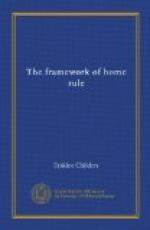These figures, to which I have often alluded in this volume, necessitate a short digression, because they and subsequent Returns of the same sort form the only official data upon which to estimate the present financial position of Ireland.
They were extracted partly from annual Returns originally issued by the Treasury for the Home Rule Bill of 1893, and entitled “Financial Relations (England, Scotland, and Ireland),” and partly from a new document known as the “Pease” Return, No. 313 of 1894. These Returns, taken together, represented the first serious attempt by the Treasury to construct an account covering a period from 1819-20 to 1890-91, and showing (a) the exact revenue derived from Ireland and Great Britain respectively; (b) the local expenditure in Ireland and Great Britain respectively, as distinguished from Imperial expenditure incurred for the benefit of the whole United Kingdom; (c) the net contribution of Ireland and Great Britain respectively to this latter expenditure for Imperial services only.
Since 1894 two regular annual Returns have been compiled, the one showing the revenue, local expenditure, and net Imperial contribution of Scotland, Ireland, and England (including Wales), the other giving an historical summary of similar figures for Great Britain and Ireland only, from 1819-20 to the current date.
Two insoluble problems have had to be grappled with by the Treasury in preparing these Returns: first, to differentiate Imperial expenditure from local expenditure; second, to arrive at the “true” net revenue of the partners as distinguished from the revenue collected within their respective limits. Both these problems arise whenever an attempt is made to look behind a system of unitary finance into the burdens and contributions of different portions of a united realm, and the latter, though not the former, of the two may arise in just as acute a form if the realm consists of federated States with a common system of Customs and Excise.
With regard to the first problem, it is, of course, easy, in the case of a Federation, to distinguish between central, or Federal, expenditure and local, or State, expenditure, because the functions of the Federal Government and State Governments are delimited in the Constitution, and the separate expenditures form the subject of separate balance-sheets. But in a Union, and above all in a Union to which one part of the realm is an unwilling party, like that of the British Isles, it is clear that no absolutely accurate line can be drawn between Imperial and local expenditure. The Army, the Navy, and a number of other things are clearly enough Imperial, but there are many debatable items. For example, Is the upkeep of the Lord-Lieutenant an Irish or an Imperial charge? Is a loss on Post Office business in Ireland to be charged against Ireland, or should Ireland be credited with a proportion of the profits of the whole postal business of the United Kingdom? More searching




